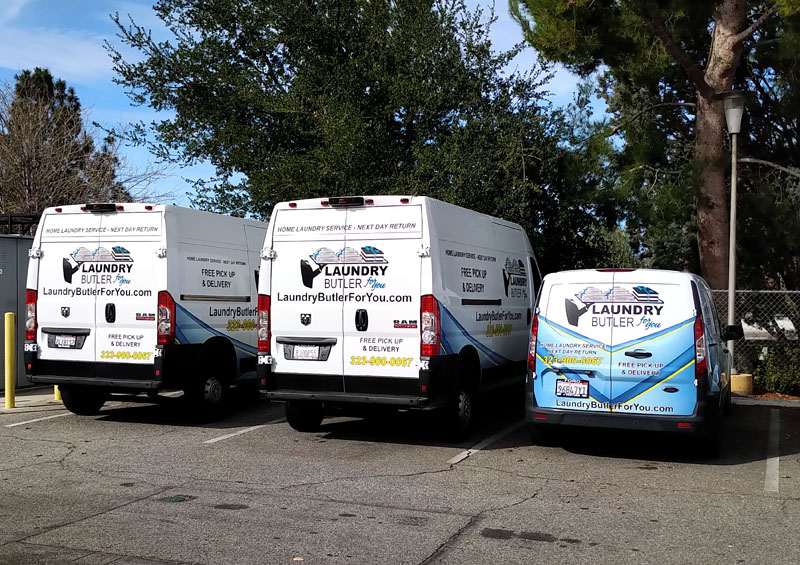A Look at One of the Most Critical Aspects for Successfully Scaling a Pickup-and-Delivery Service
[This is the second of a three-part feature article on managing a fleet of laundry delivery vehicles. You can read Part 1 here.]
Make no mistake: your delivery vans are rolling billboards for your PUD business.
“The van wraps are some of the best advertising we have,” noted Mark Vlaskamp, managing partner of The Folde – based in Houston and Austin, Texas. “Of course, there are a lot of nosy neighbors who want to know what’s going on at their neighbor’s house, so clear wraps with little clutter are how we like to style our company’s wraps.”
“I get calls from friends all the time saying, ‘I saw your Super Suds van,’” shared Matt Simmons of Super Suds Laundromat in Long Beach, Calif., who estimated that a decent van wrap will cost about $2,500.
“A good wrap makes your vehicle very recognizable,” he explained. “It’s important to include the branding, the service you provide, who you help, and a call to action. And the wrap needs to tell people that you service residential and commercial laundry; if you don’t mention residential, many people will assume laundry pickup and delivery is for commercial businesses only.”
Simmons added that the call to action should include your business’ website, as most consumers these days don’t want to call. Also, make certain that the most important information is located toward the top – because, if your phone number or website are at the bottom of your van, it often will be blocked by traffic.
“We place an infographic at the bottom of our wrap design, which tells a story but is not essential,” Simmons said.
Rather than a full wrap, Brio Laundry in Bellingham, Wash., works with a local design firm to create stickers for its delivery vehicles.
“The stickers cost a few hundred dollars each, but we can rotate what message we want people to see,” Brio’s Travis Unema explained. “It’s important for the customer to know and recognize that it’s our vehicle, not a random person – think about UPS, with its brown trucks and uniformed employees.”
Whatever type of exterior customization you eventually choose, Art Jaeger of Laundry Butler For You, based in Simi Valley, Calif., pointed out the double-edged sword of an easily identifiable delivery van.
“Your name is on the vehicle,” he warned. “You’re building your presence in the community. You’re letting others see that you’re in the neighborhood. But I’ve also received calls from people telling me about my drivers going through stop signs or speeding. So, it’s important to understand that it can blow back negatively on your company if your drivers aren’t doing what they should.”
Staying on the Road
Any delivery vehicle that isn’t on the road isn’t making your business money. And routine preventative maintenance is the best way to avoid this problem.
“We track maintenance through a software provided by our leasing company,” explained Beck Miller of 2ULaundry in Charlotte, N.C. “However, there are several off-the-shelf software products that do this, as well as free workarounds such as manually tracking them on Google Sheets. Above all, it’s important to keep your fleet fully serviced.”
At The Folde, a full-time logistics manager is on staff to coordinate all of the company’s vehicle maintenance. “Just like with doing laundry, preventative maintenance is the name of the game,” Vlaskamp stated.
“Our drivers drive the vans hard, and they brake hard, too,” Simmons said. “We get top-quality brakes. We also use Bridgestone General or Firestone tires, as we’ve found that American-made tires last much longer than some of the other brands.
“Get truck-rated tires, because they last longer than standard tires and will save you money in the long run,” he continued. “It’s a heavy vehicle, carrying a heavy load.”
Simmons added that Super Suds has set up accounts with vehicle maintenance shops in the area so that their drivers can take the vans in themselves and accounts are already set up.
“We pre-negotiate prices for regular service items such as replacing tires and brakes, as well as oil changes,” he noted. “And be sure to ask for ‘fleet pricing.’”
In addition to routine three-month preventive maintenance, Brio’s vehicles undergo weekly inspections of the tires, oil levels, coolant, directional signals, lights, lift gate, straps, windshield wipers, and just general cleanliness and organization. Unema said the company encourages its drivers to “take ownership of their vehicles.”
“Develop a relationship with a local rental company,” Unema also suggested. “Often, they do repairs as well. And choose one that rents vehicles similar to what you have so that you can rent from them while yours may be in the shop. It’s cheaper to pay for a rental while you fix your own vehicle than to have a van down and be scrambling.”
For Laundry Butler For You, vehicle maintenance got much easier once Jaeger’s son, Alex, noticed a local Midas dealership whose parking lot always seemed to be filled with Amazon vans – which coincidentally are Ram ProMasters, the same vehicles preferred by Laundry Butler.
“As it turns out, that facility does all of the vehicle maintenance on the ProMasters for the nearby Amazon dispatch station – so that’s where we go now, too,” Jaeger explained. “They understand the vehicles, and they stock all of the ProMaster parts, so there’s never a delay. Also, they’re used to turning around these vehicles quickly because they know we need our vans on the road. After all, it’s a major part of their business.”
In Part 3, our panel of pickup-and-delivery operators will discuss the human element of a PUD service, the driver. They’ll also shed light on a few key pricing considerations and share some final pieces of advice on managing a PUD fleet.












